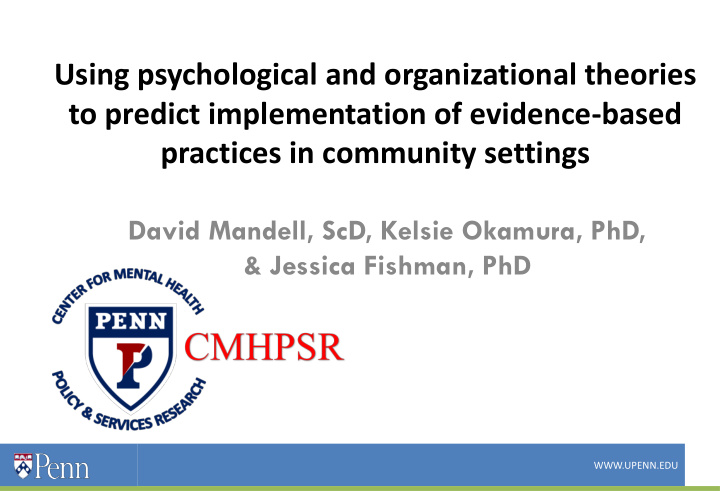



Using psychological and organizational theories to predict implementation of evidence-based practices in community settings David Mandell, ScD, Kelsie Okamura, PhD, & Jessica Fishman, PhD WWW.UPENN.EDU 1 12/7/2017 1
Implementation science is the study of adult behavior change. 2 https://performancegrapevine.com/2014/02/09/to-get-your-team-to-embrace-change-reverse-the-alphabet/
Great frameworks of factors affecting implementation Damschroder et al., 2009 3
These factors must act on practitioner to affect implementation or directly on population to affect outcomes 4
A modest proposal Organization Intentions Use of EBP Culture and Climate Williams & Glisson, 2014 5
Azjen, 1991) 6
Psychological variables I am willing to [perform this EBP]. Intention Strongly Disagree __:__:__:__:__:__:__ Strongly Agree [Performing this EBP] would be: Attitude Good__:__:__:__:__:__ :__Bad Pleasant __:__:__:__:__:__ :__ Unpleasant Beneficial __:__:__:__:__:__ :__Harmful Enjoyable __:__:__:__:__:__ :__ Unenjoyable Wise __:__:__:__:__:__ :__Foolish Most people who are important to me think I should [perform this EBP]. Perceived Norms Strongly Disagree__:__:__:__:__:__ :__Strongly Agree Most teachers who are like me [perform this EBP]. Strongly Disagree__:__:__:__:__:__ :__Strongly Agree If I really wanted to, I could [perform this EBP]. Self-efficacy/ Perceived Strongly Disagree__:__:__:__:__:__ :__Strongly Agree Control [Performing this EBP] is completely up to me. Strongly Disagree__:__:__:__:__:__ :__Strongly Agree
Azjen, 1991) 8
Our Causal Model Policy/ Federal Organizational State Environment City Attitudes Org Beliefs Norms Intentions Behavior Knowledge Self-Efficacy Skill Adapted from Azjen (1986, 1991) and Williams and Glisson (2014) WWW.UPENN.EDU 12/7/2017 9
Our Causal Model Policy/ Federal Organizational State Environment City Attitudes Org Beliefs What Norms Intentions Behavior Behavior? Knowledge Self-Efficacy Skill See for example: Reding et al., 2014; Stirman-Wilson et al., 2016
EBP comprise complex repertoires Cognitive Behavioral Therapy Beh Interventions for Autism • Cognitive restructuring • Praise to behavior correction ratio • Exposure • Token economy • Behavioral activation • Visual schedules • Problem-solving • One-to-one interventions like • Agenda setting discrete trial training or pivotal • Homework response training • Data collection • Data collection 11
Autism support teacher's intentions to use these practices Strongly agree Strongly 70% agree 60% Strongly Strongly 50% agree agree 40% 30% 20% 10% 0% positive reinforcement schedules one-to-one instruction data collection Fishman et al, in press
Logistic regression predicting use of schedules Adjusted Odds Ratio Each additional year of autism teaching experience 1.0 Each additional student in the classroom 1.0 Each additional support staff in the classroom 0.4 Teacher was trained in using schedules (y/n) 6.8 Teacher strongly agrees with the statement, “I intend 5.2 to use visual/verbal schedules individualized for each student every day during the next four weeks”
Autism support teacher's intentions to use these practices Pedagogy 70% 60% Resources 50% Staffing 40% Attitudes 30% 20% 10% 0% positive reinforcement schedules one-to-one instruction data collection Fishman et al, in press
Still many things to work out Policy/ Federal Organizational State Environment City Attitudes Org Beliefs Norms Intentions Behavior Knowledge Self-Efficacy Skill Adapted from Azjen (1986, 1991) and Williams and Glisson (2014) WWW.UPENN.EDU 12/7/2017 15
Still many things to work out Policy/ Federal Organizational State Environment City Attitudes Org Beliefs Norms Intentions Behavior Knowledge Self-Efficacy Skill WWW.UPENN.EDU 12/7/2017 16
Two Tests Beidas et al. Locke et al. 17
Thank You! mandelld@upenn.edu @dsmandell www.cmhpsr.org/dr-david-mandell P50MH113840 · R01MH106175 · R21MH106887 WWW.UPENN.EDU 18 12/7/2017 18
Recommend
More recommend